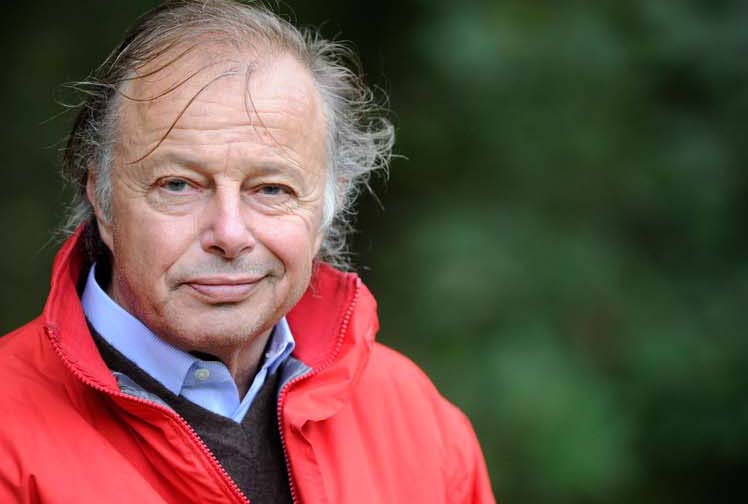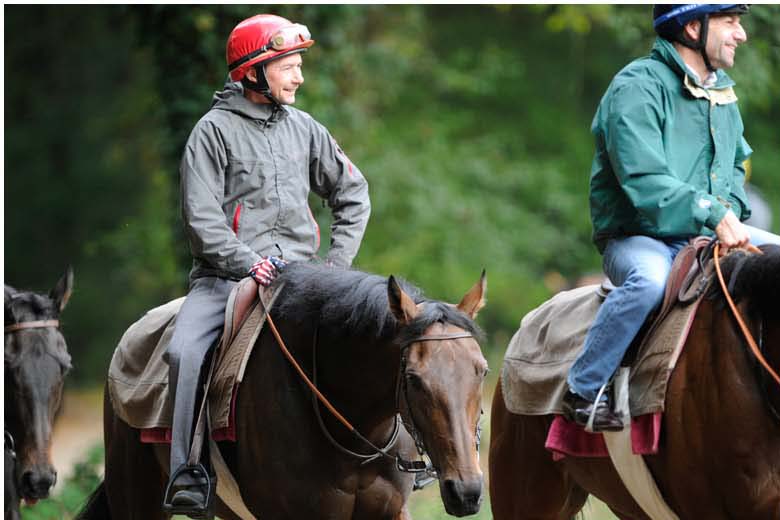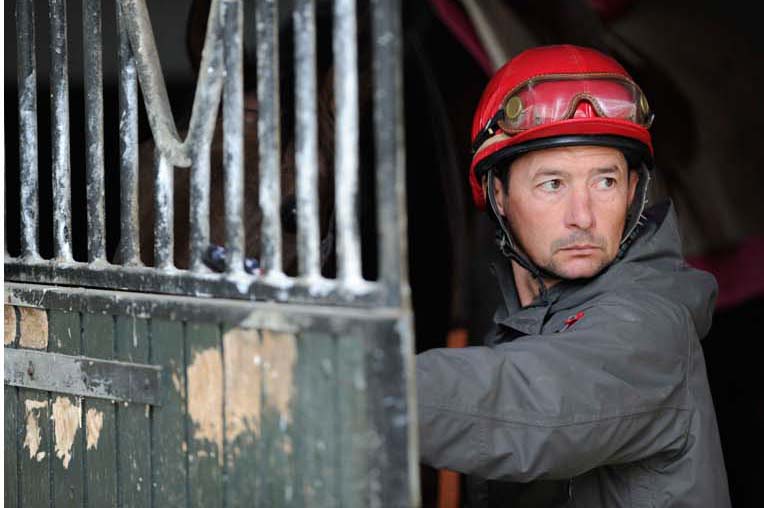The true gauge of a great racehorse is that it must stir the blood as it approaches the starting stalls. It is the defining moment. To watch one in action is to drink a dizzy cocktail of excitement and apprehension.
Great racehorses are like actors on the stage: their presence is enhanced by the distance between them and their audience. Yet meet them backstage, stripped of their costumes, and they become flesh and blood.
To visit Goldikova at home is to see a similar transformation. She receives no special treatment; she dwells anonymously in the middle of a long line of boxes. Freddy Head, who has trained her with such dexterity, can’t even see her from the windows of an office where he is obliged to spend most afternoons.
Nor do the staff pay homage on this routine morning. She is simply there: one among a hundred horses on a sun-kissed day, sometimes peering out from the front of her stall, at others retreating into quiet sanctuary. She spends more time back there than out front.
It’s no different cometh the hour for daily exercise. The horse stabled furthest from the opening to the Chantilly forest exits first, followed by the one next door, and so on. One by one they emerge until it is Goldikova’s turn to file in.
The person least familiar with Goldikova is the resident vet, who never has cause to attend her
She does so with no fuss. Nothing whatsoever demarks her as she makes her way towards gallops she knows so well. She is in rehearsal, bereft of grease paint, going through the motions. Her behaviour changes only when a change to her morning routine prefaces an imminent performance.
At first, it’s a little disappointing. Here stands a thoroughbred titan: winner of 14 Group 1 races, nine of them against colts, and bound for a crack at an unprecedented fourth victory in the Breeders’ Cup Mile. Yet here, within the walled perimeters of Head’s stables on Avenue du General Leclerc, she is one of a crowd. Nothing in the demeanour of anyone around her betrays the fact that these are some of the last days Goldikova will be in their midst.
Only when morning exercise is complete do the shutters part. Goldikova is no statue: she’s a living, breathing mass of energy who needs to stretch her legs to draw the sap from her. To discover her essence requires peering below the surface into depths which those outside the stable are rarely afforded.
As she dries out from her post-gallop wash, the first thing that strikes you is her clean limbs. There’s not a mark on them after five years of hard racing. The person least familiar with Goldikova is the resident vet, who never has cause to attend her. She’s as sound as the day she was foaled, when expectations were immediately dampened by her lack of size.

Freddy Head, rider of Miesque, trainer of Goldikova
To this day Head cannot pinpoint what it was about the yearling by Anabaa, whom he rode to champion sprinter honours, that caught his eye when he saw her roaming the paddocks. His request to train her was readily accommodated; she was not coveted by others in the Wertheimer ranks.
And there were no takers when Goldikova’s stable lass left towards the end of 2007, when the champion-in-waiting still resembled an unfurnished clothes horse. But Head’s vastly experienced head lad, Bruno Huet, had already seen enough.
“She was late in when she arrived,” Huet reflects. “We could see that she had talent, but that she also needed time. Then one day in September of her two-year-old season she did a gallop that showed she was ready for a race. She ran twice at two; not in big races, but she won both times.”
Then followed a process that would repeat itself in the following four years as Goldikova wintered at the Wertheimer stud, in Normandy. Every time she returned to Chantilly she looked a little stronger.
“The change in her physically since she first arrived has been huge,” Huet asserts. He says he has never seen another racemare with her iron constitution.

Goldikova at exercise in the forest at Chantilly
The beauty of thoroughbreds of Goldikova’s vintage is that they are fully mature. There is immense strength in her shoulder, which is perfectly rounded, while her hind quarters are robust enough to pull a cart with ease. Her head, set atop a mildly cresting neck, is anything but effeminate.
Perhaps that’s because she is constantly pulling faces and pinning her ears back. She is also prone to repeatedly stamping her off-hind. It is no act. As you step forward to pat her, Thierry Blaise, her long-time lad, issues a word of warning.
“Attention,” he mutters as he steps between you and the mare. Sure enough, Goldikova curls her lip at the intrusion, shaping as if to bite before backing off.
“In all the years her temperament has always been the same,” Blaise explains. “She is very dominant, a real male in character, but she won’t go for me because she has become used to me. She is much better with one person.”
The truth of the matter is that Goldikova is decidedly anti-social. If you approach the front of her box she bustles forward to head you off. She may have a mouthful of hay but it isn’t enough to keep her teeth occupied. She’d take a pound of flesh as soon as her beloved carrots.
Blaise calls her “la vieille”; the old one
Blaise looks on from the background, talking to her in monosyllables. The bond between them is born of a mutual understanding, from recognition that Goldikova is happiest when she is left to herself.
Blaise calls her “la vieille”; the old one. He won’t actually say it, but he conveys the impression he will not lament Goldikova’s imminent retirement. Horses have a finite racing life and hers is nearing its end. Blaise senses it in her. It’s almost as if he would prefer to see her out on the pasture than to be here like a caged tiger.
To make the point, Blaise takes Goldikova over to lawn in the middle of the square yard; she all but yanks the reins from him in her desire to get at it. There is intent in the way she thrusts her head down towards grass she grazes to her heart’s content in winter, but which is denied her in the racing season.
For the last four seasons that has involved trips to Deauville. Goldikova has won there every year but Blaise says it is not her favourite place. There is no privacy; horses are stabled in rows of barns, as they are on American racecourses. And that means a constant stream of visitors straining for a glimpse of the mare who has bewitched the whole of France.
It is Goldikova’s idea of hell; so much so that she stopped staying in Deauville, to where turfistes decamp for August. She is happier shuttling back and forth from familiar surroundings at Chantilly. She knows those surroundings intimately, even if it took her a while to establish them.
The key has been to leave her unstressed at all times. On her formative work mornings she would strain at the leash if asked to settle in behind. Everything is a competition to her; she has long since galloped alone.
Even in regular exercise, as on this morning, she dips her head low towards the ground in trademark style. There is an abundance of enthusiasm at the gallop, but on her return to the yard she dissolves into the rest of the string. Just as she prefers.
Racing stables are largely devoid of sentiment. Their mission is to keep the wheels turning as smoothly as possible. To Head’s staff on this Thursday morning the priority is to count horses out to the gallops and count them back again. Only over coffee in the tack room does the collective engine pause.
Tack rooms are the heart and soul of any stable. And here, at last, is evidence of Goldikova’s hallowed place in the scheme of things. Her bridle, a Chifney linked to a common snaffle bit, occupies the first peg inside the door.
An assortment of photographs chronicling Head’s early career now struggle for space among those depicting Goldikova’s many triumphs. And right in the middle of the banter stands Regis Barbedette, Head’s travelling head lad, with a link from the present to the past.
Barbedette and Head go back a long way. In the 1980s he worked for the late Francois Boutin, to whom Head was stable jockey when Miesque graced the yard. And Barbedette makes no bones about it: Goldikova is better than Miesque ever was.
“Sure, she has been beaten three times this year,” Barbedette says, “but take no notice. The tracks in America are perfect for her. They favour fast horses much more than the straight mile at Ascot and Deauville. I truly believe she will win her fourth [Breeders’ Cup] Mile at Churchill Downs – especially if it does not rain.”
Out in the yard, Blaise has done just about all he needs to do to wrap up Goldikova’s morning. He walks around her as she is tied to the back wall; she does mostly as he commands. When she doesn’t, Blaise cuts her some slack.
“No point in making a big issue out of something small,” he says by way of explanation. “She likes to feel that she is in charge, which is fine unless she starts getting silly.”
At that point Goldikova gets restless. Blaise says that because of our chat, he is taking longer over his chores than usual – and la vieille is growing impatient. She cocks her off-hind, as she has done several times this interlude, but on this occasion she lashes out at thin air behind her.
Blaise moves quickly up to her head, unties her chain and walks calmly out of the box. Goldikova spins round towards the door, her ears flat back, her eyes glowering with affront at being detained.
She then retreats to the rear, where she shuffles around on her feet until she is as comfortable as her restlessness will allow. It is as though she herself is counting down the days.
A natural fit for Goldikova

Thierry Blaise
Thierry Blaise knows a thing or two about celebrated horses, even if they performed under a different code. Before joining Freddy Head five years ago he worked for Bernard Secly, who scaled rare heights with his jumpers.
Blaise’s time there overlapped with two of Secly’s best. Katko was France’s equivalent of Best Mate: he won the Grand Steeplechase de Paris for three straight years from 1988. And Katko was succeeded by the remarkable Al Capone, winner of another prestigious race, the Prix La Haye Jousselin, for seven consecutive years from 1993.
Although he never rode in a race, Blaise, 43, rode those equine legends in their homework. He is stronger than most lads from a Flat background and this made him a natural fit for the young, headstrong Goldikova when her lass left Head’s stable in 2007.
Then a backend two-year-old, Goldikova had already developed a reputation for being hot to handle. “Nobody wanted to look after her,” Blaise recalls. “At that time she was very angular and thin; it wasn’t obvious that she would turn out so good.”
Her metamorphosis is now complete. “She got stronger and stronger as she aged,” he says. “Now she is six, she can’t really do any better.”
Does Goldikova know she is good? “Yes, I think so,” Blaise avers. “When she started winning big races more and more people wanted to see her, but that made her more determined to be on her own.
“She is happiest here in Chantilly, but she doesn’t mind going to the Breeders’ Cup with the other French horses because she can stay in the background. On her first trip (to Santa Anita in 2008) she was a bit difficult but now she is very calm on the journey.”
There’s no doubt Blaise has been instrumental in allowing Goldikova to express her abundant talent. A less patient, less tolerant lad might have risen to Goldikova’s bait rather than establish ground rules which both parties are comfortable with. To that end Blaise has not missed one single day with Goldikova: he takes all his holidays in the off-season.
He is reticent when asked what Goldikova means to him. Theirs is a symbiotic relationship based on the long-established principle of one man, one horse. It is unromantic and far removed from the adrenaline rush Goldikova generates in winning her races.
Blaise has made one concession to Goldikova’s brilliance. Each day he rides out in a pair of worn gloves with a stars-and-stripes motif. He points to them with an embarrassed smile and says: “A souvenir, from America. This will be her last Breeders’ Cup; maybe I will buy some more at Churchill Downs.”
And with that, he vaults aboard Goldikova to join the string for morning exercise. How he will feel when he does that for the last time, only he will know.



